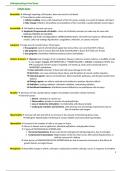Pathophysiology Final Exam
Cellular Injury
Reversible Although impairing cell function, does not result in cell death.
Two patterns under microscope:
1 Cellular swelling: occurs with impairment of Na+/K+ pump, usually as a result of hypoxic cell injury
2 Fatty change: linked to intracellular accumulations of fat; reversible, usually indicates severe injury.
Irreversible Cell death or necrosis can occur.
Apoptosis (Programmed cell death): a form of cell death necessary to make way for new cells;
NORMAL PROCESS IN THE BODY
Necrosis: cell death and degradation; UNREGULATED death; cell swells and ruptures; inflammation
results. Cells may undergo liquefaction, coagulation, infarction, or caseous necrosis
Gangrene Large area of necrotic tissue; Three types:
1 Dry gangrene: lack of arterial blood supply but venous flow can carry fluid OUT of tissue
2 wEt gangrene: lack of venous flow lets fluid ACCUMULATE in tissue (E fluid can ‘E’nter)
3 Gas gangrene: Clostridium infection produces toxins and bubbles
Cellular stressors Hypoxia: lack of oxygen in air, respiratory disease, ischemia, anemia, edema, or inability of cells
to use oxygen. Causes: ATP DEPLETION or “POWER FAILURE”; AEROBIC metabolism STOPS, less
ATP is produced, Na+/K+ pump is impeded, cell swells up, lactic acid is produced due to
ANAEROBIC metabolism.
Heat and Cold: extremes of heat and cold cause damage to the cells
Electricity: can cause extensive tissue injury and disruption of neural/ cardiac impulses
Chemical agents: injures cell membrane, block enzymatic pathways, and disrupt osmotic/ionic
balance
Biologic agents: are able to replicate and continue to produce injurious effects
Radiation: ionizing radiation, ultraviolet radiation, nonionizing radiation
Nutritional imbalances: Nutritional excess/deficiency can predispose cells to injury
Atrophy decrease cell size causing reduce oxygen consumption and other cellular functions.
General causes:
1 Disuse: reduction in muscle use
2 Denervation: atrophy in muscles of paralyzed limbs
3 Loss of endocrine stimulation: in relationship with disuse atrophy
4 Inadequate nutrition and ischemia: cells decrease size and energy requirements due to
lack of nutrition and oxygen.
Hypertrophy increase cell size and with it an increase in the amount of functioning tissue mass.
Pathogenic Hypertrophy: thickening of urinary bladder and myocardial hypertrophy.
Hyperplasia increase in the number of cells in an organ or tissue.
Occurs in tissues such as epidermis, intestinal epithelium, and glandular tissue.
2 types of PHYSIOLOGICAL HYPERPLASIA:
1 Hormonal hyperplasia: Breast and uterine enlargement during pregnancy, due to estrogen.
2 Compensatory hyperplasia: Regeneration of the liver that occurs after partial hepatectomy, or
with the removal of a kidney.
Most forms on NONPHYSIOLOGICAL HYPERPLASIA are due to excessive hormonal or the effects of
growth factors on target tissues.
Metaplasia Reversible change in which a cell type is replaced by another cell type, occurs in response to irritation
1
,Pathophysiology Final Exam
and inflammation. (‘M’ is like mix-and-match)
Dysplasia deranged cell growth of a specific tissue, results in cells that varies in size, shape, and organization
Strongly implicated as a precursor of cancer; reversible change
Hypoxia lack of oxygen supply to the tissue despite of good perfusion of blood.
Ischemia Decreased blood supply to a body organ or part usually due to functional constriction or obstruction.
ISCHEMIA commonly depends on blood flow through limited numbers of blood vessels and produces
LOCAL TISSUE injury
IMMUNE DISORDERS AND IMMUNODEFICIENCY
HIV retrovirus selectively attacks CD4+ T lymphocytes; pt. infectious even when asymptomatic
Unprotected sexual activity; blood, semen, vaginal fluids, oral intercourse; Contaminated blood; infected
mother to child, breast milk, placenta, needles, blood transfusions
Stage 1 Occurs shortly after infection, high viral load
Symptoms: flu like symptoms; GI issues; Lymphoadenopathy, rash; viral replication, CD4+ cell count
Stage 2 Latent Period, lowest viral load
Symptoms: Asymptomatic of illness; CD4+ count drops progressively ; 200-499 cells/ᵤL; Risk for
opportunistic infections; Inflammation in more than 2 areas for > 3 months
Stage 3 AIDS phase, caused by HIV infection of cells, viral load increases, suppressed immune system and
opportunistic infections, malignancies, wasting and CNS degeneration.
Symptoms: Occurs when CD4+ cell count is less than 200 cells
Respiratory: pneumocystis carinni pneumonia (PCP), pulmonary TB (can migrate anywhere in the body)
GI: esophageal candidiasis, CMV infection, herpes simple virus, diarreah, gastroenteritis
Nervous System: taxoplasmosis (cat poo)
Malignancies: Kaposi sarcoma, non-hodgkins, lumphoma
Diagnostic HIV tests
1. ELISA enzyme-linked immunosorbent assay (ELISA) screens for HIV antibodies.
2. Western blot test to confirm a positive Elisa test.
3. Polymerase Chain Reaction (PCR) most accurate, most expensve
Nursing Assessment Weight analysis, LOC, Reports of pain
Skin; palpation of lymph nodes, VS, lung sounds, oral cavity, rectal and vaginal exam
HEMATOLOGIC DISORDERS
MVC Normocytic: normal size; normal MVC
Macrocytic: large size; high MVC
Microcytic: small size; low MVC
MCHC Normochromic: normal amount of Hb; normal MCHC
Macrochromic: concentrated amount of Hb; high MCHC
Microchromic: diluted amount of Hb; low MCHC
2
,Pathophysiology Final Exam
Hypercoagulability Increased platelet function
Diabetes Mellitus: if they develop CHF at risk for clots.
Smoking and oral contraceptives directly correlated in developing clots
Arterial Thrombi, Atherosclerosis, atrial fibrillation, blood clots arise from heart cause
strokes, and murmurs
Venous Thrombi: incompetent valves w/in veins
Thrombocytopenia Platelet less than 100,000, most common cause of abnormal bleeding and loss of bone
marrow function occurs
Excessive consumption of platelet (DIC chews up platelets, usually occurs from sepsis)
Excessive pooling of platelets in spleen
Causes: drug induced Thrombocytopenia; Heparin Induced Thrombocytopenia (HIT); Patients
allergic to heparin: platelets drop by more than 10%; Immune Thrombocytopenia Purpura (ITP)
Signs and Symptoms mucus membranes bleeding: nose, mouth, GI, and uterine cavity. Occurs in small vessels
Acute ITP most common bleeding disorder in children
Chronic ITP most common in adults
Excess destruction of platelets by body, platelet production decreased 1-3 days
Petechiae (purplish red spots), Purpura (purple areas of bruising in large areas)
DIC Disseminated intravascular coagulation; complication of other disorders, bleeding and clotting at the same
time, seen in septic pts or severe trauma, cancers, and hematologic conditions
Treated w/ heparin as blood is transfused as well
Post partum: amniotic emboli can occur along with DIC
H1N1 also caused DIC in some pts
Hodkin Lymphomareplacement of normal cell by Reedsternberg cells, mutation of T- lymphocyte.
starts in single lymph node and spreads to neighboring lymph node. Eventually infiltrates
liver, spleen, lungs, bone marrow, and ureters.
2 Categories:
1.Nodular lymphocyte predominant Hodgkin lymphoma, unique form that exhibits a nodular
growth pattern
2.Classical Hodgkin lymphoma is characterized by clonal proliferation of typical mononuclear
Hodgkin cells
Unknown etiology, but exposure to carcinogens and viruses, genetics and immune
mechanisms has been proved to be the involved.
Common in early adulthood (15-40) and in older adulthood (>55); Most common in men
Signs and Symptoms Painless enlargement of a single node or group of nodes; initial lymph above the diaphragm
Chest discomfort with cough and dyspnea.
Fever, night sweats
Weight loss
Pruritus (itching)
Advance stages of HL: liver, spleen, lungs, digestive tract, and CNS are involved.
Diagnostic Test presence of Reed Sternberg cells in biopsy
CT scans of chest and abdomen.
Thrombocytosis, leukocytosis, eosinophilia, elevated erythrocyte sedimentation rate (ESR),
elevated alkaline phosphatase
3
, Pathophysiology Final Exam
Non-Hodkin Lymphoma malignant transformations of either T or B cells during differentiation in peripheral
lymphoid tissue. Originates outside the lymph and distributes rapidly.
The NHLs are multicentric, spread early to several lymphoid tissues throughout the body
specially liver, spleen, and bone marrow.
linked to viral/bacterial infections, environmental agents, immunodeficiency, and
autoimmune disorders
MORE AGGRESSIVE, B cell malignancy affects T cells and macrophages
DOES NOT HAVE REEDSTERNBERG CELLS
Most common in men between 50 – 70
Common in pts. with HIV, chronic immunosuppressive therapy after organ
transplantation, and with acquired or congenital immunodeficiency.
Signs and Symptom Painless lymphodenopathy (cervical usually first, then axillary, and the inguinal)
Fever, Night sweats
Dyspnea
Renal failure
Weight loss
Diagnostic Test and Treatments Lymph node biopsy and immunophenotyping to determine the lineage and
clonality
Bone marrow biopsy, blood studies, chest and abnormal CT scans, MRI
Staging the disease is important to determine the treatment
Anemias
Hemolytic Anemia Premature destruction of red blood cell; Retention of iron from hemoglobin destruction
increase in Erythropoisis, normocytic and normochromic red cells
Intrinsic: with in, defect of red cell membrane
Extrinsic: defect outside (drugs, bacteria, toxins, trauma)
Heart or valve malfunction
Sepsis: microorganism can lead to RBC destruction
Sickle cell decreased plasma oxygen hemoglobin S causes RBC to elongate, clump together obstructing blood
flow, or adhering to the vessel endothelium causing ischemia, thrombosis or tissue infarction.
With normal oxygenation, sickled RBCs resume their normal shape.
Common sites obstructed: abdomen, chest, bones, and joints
caused by hypoxia, low environmental and/or body temperature, excessive exercise, high altitudes or
inadequate oxygen during anesthesia, and stress.
caused by blood viscosity, decreased plasma volume, infection, dehydration, and/or increased
hydrogen ion concentration (pH/acidosis).
Acidosis reduces affinity of hemoglobin for oxygen, increasing sickling.
Repeated episodes of sickling and unsickling weaken cell membranes, causing them to hemolyze
(breakdown) and be removed. Episodes can last 4-6 days.
Acute chest syndrome: atypical pneumonia from pulmonary infarction characterized by infiltrates,
shortness of breath, fever, chest pain, and cough
Signs and Symptoms Strokes (another mayor complication)
Retinal infarcts (blindness)
Lung infarcts (pneumonia, acute chest syndrome)
Pigment gallstones
4





